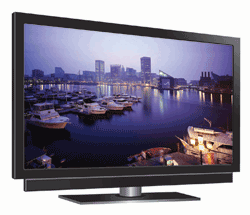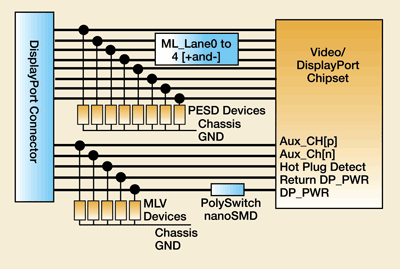Circuit protection for LCD-TV backlighting, supplies
Good grounding practices, coupled with robust circuit-protection devices, can enhance transient protection
BY MATT WILLIAMS
Tyco Electronics’ Raychem Circuit Protection, Menlo Park, CA
http://www.raychem.tycoelectronics.com
Advanced LCD technology has resulted in larger screens, wider viewing angles, and higher-quality video images. However, as LCD-TV screens grow bigger and brighter, they require more voltage and current to operate, increasing the need for more robust and reliable circuit protection techniques.

A variety of circuit protection devices can be used to help protect the LCD screen from damage caused by excessive current or voltage transients. Overcurrent protection may take the form of a fuse or a resettable polymeric positive temperature coefficient (PPTC) device. Deciding whether to specify a PPTC device or a single-use fuse depends on the LCD design and the types of threats the device may face.
PPTC devices are commonly applied to circuits that experience high inrush currents on startup. PPTC devices are resilient to inrush currents and help eliminate the nuisance of blown fuses. Fuses are well suited to circuit designs where resettability is not desirable, or where faults occur only in a system failure condition. They are also a practical solution when soft-start circuitry is used to limit inrush current.
To enhance equipment safety and reliability, a variety of overvoltage protection devices including metal oxide varistors (MOVs), multilayer varistors (MLVs) and electrostatic discharge (ESD) surge protection devices can be used in a coordinated scheme with overcurrent protection devices, as discussed here.
LED backlighting protection
LED backlighting enhances the viewing experience, offers more flexible backlight architectures, and enables thinner display designs than conventional cold-cathode fluorescent lamp (CCFL) technology. Other benefits include higher efficiency, reduced power consumption, a longer lifespan, enhanced durability, and better contrast ratios for clearer definition on-screen.
LEDs require precise power- and heat-management systems, since most of the electrical energy supplied to an LED is converted to heat rather than light. Without adequate thermal management, this heat will have a negative effect on both the LED’s lifespan and the color output.
Power-line-coupled transients and surges can also reduce LED lifespan, and many LED drivers are susceptible to damage resulting from improper dc voltage levels and polarity. LED-driver outputs may also be damaged or destroyed by short circuits.
Most LED drivers for LCD-TV applications include built-in safety features, including thermal shutdown, as well as open and short LED detection. However, additional overcurrent protection devices may be needed to help protect integrated circuits (ICs) and other sensitive electronic components.
PPTC devices can also be used to help prevent thermal runaway, which may occur if the monitor’s cooling vent is blocked. Due to its ability to detect and respond to overtemperature, a PPTC device mounted in the appropriate location can interrupt current in the event the LEDs are operating without adequate ventilation.

Fig. 1. Overtemperature protection scheme for LED backlighting.
Figure 1 shows how a PPTC device is connected in series with the LED to help provide overcurrent protection. To fully leverage the PolySwitch device, it can be thermally bonded to the metal core circuit board or LED heat sink. If the LED is not equipped with built-in ESD protection, a PESD protection device, placed in parallel with the LED, can help protect against damage caused by ESD surges.
Overcurrent and overvoltage protection for I/O ports
I/O port protection helps keep components safe from short-circuit damage and improves reliability and customer safety. To meet regulatory agency requirements, I/O ports must supply a method of interrupting or limiting current in the event of an overload or short circuit.
As data rates increase and circuitry becomes smaller and more sensitive, protecting equipment from damage caused by circuit transients becomes even more critical. The HDMI, USB, and DisplayPort specifications require that end-user-accessible, powered connectors implement overcurrent protection. The overcurrent protection device must be resettable, without user mechanical intervention, and its preset trip limit must be above allowable current transients in order to prevent false trips.
PPTC devices have demonstrated their effectiveness in a variety of high-speed interface applications. Like traditional fuses, they limit current after specified limits are exceeded. However, unlike a fuse, PPTC devices have the ability to reset after the fault is cleared and the power is cycled. Their low resistance, fast time-to-trip, and small form factor have made them the preferred method of overcurrent protection in many powered bus architectures.
Powered ports are also susceptible to damaging overvoltage transients, including ESD pulses. Figure 2 shows a typical circuit protection design using a PolySwitch device for overcurrent protection, as well as PESD devices and MLVs, which help protect against damage caused by overvoltage conditions.

Fig. 2. Typical DisplayPort circuit protection design ustilizing MLV devices, PESD suppressor devices, and a PolySwitch overcurrent protection device.
The MLV provides low-capacitance shunt protection and offers the high current-handling and energy-absorption overvoltage protection required for LCD TV applications. The PESD arrays are installed over the data lines to help shunt ESD away from sensitive circuitry. The PESD device’s low capacitance helps prevent degradation of high-data-rate signals.
Multioutput power supply protection
Switch-mode power supplies (SMPSs) offer the size, weight, and energy-saving advantages required for consumer electronics, and have continued to replace linear-regulators in many applications, including LCD TV monitors. However, because SMPSs lack the inherent resistance of prior-generation designs, they often require more robust circuit protection.
PPTC overcurrent protection devices can help manufacturers meet UL60950-1/LPS (Limited Power Source) requirements for SMPSs and help improve equipment safety and reliability.
The PPTC device has a low-resistance value under normal operating currents. In the event of an overcurrent condition, the device trips into a high-resistance state. This increased resistance helps protect the equipment in the circuit by reducing the amount of current that can flow under the fault condition to a low, steady-state level. The device remains in its latched position until the fault is cleared. Once power to the circuit is cycled, the PPTC device resets and allows current flow to resume, restoring the circuit to normal operation.
While PPTC devices cannot prevent a fault from occurring, they respond quickly, limiting current to a safe level to help prevent collateral damage to downstream components. Additionally, the small form factor of PPTC devices makes them easy to use in space-constrained applications.
As shown in Fig. 3 , a PolySwitch device can be installed in series with the power input to help protect against damage resulting from electrical shorts, overloaded circuits or customer misuse. Additionally, a MOV placed across the input helps provide overvoltage protection in the LED module.
The PolySwitch device may also be placed after the MOV. Many equipment manufacturers prefer protection circuits combining resettable PPTC devices with upstream fail-safe protection. In Fig. 3, R1 is a ballast resistor used in combination with the protection circuit.

Fig. 3. Typical circuit protection design for switch-mode power supplies.
There are well defined requirements for fault protection at LCD TV interfaces, with specific standards addressing various fault protection needs. It is always good practice to apply protection devices as close as possible to the chip sets’ I/O and VCC pins, as board traces may be susceptible to conducted transients. Good grounding practices, coupled with robust circuit-protection devices, can enhance transient protection, help reduce warranty returns and repair costs, and facilitate compliance with applicable standards. ■
Advertisement
Learn more about TE Connectivity





